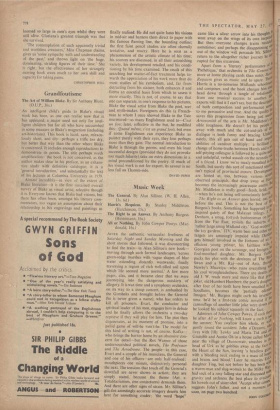Poor Things
Two Tudor Portraits. By Hester Chapman. (Cape, 25s.)
MISS CHAPMAN is an expert biographer. She has a sensitive, imaginative approach, and she is thorough and conscientious in discovering and using sources. She specialises in secondary characters, 'minor attendants on the Muse of History,' but she uses their lives to throw light on the general life of their times. The Earl of Surrey, the poet, as Miss Chapman admits, was not an attractive person. 'It is the most foolish proud boy that is in England' was said of him when he was twenty-three years old and a father. Surrey was indeed arrogant, overbearing and rash to the point of being unbalanced. But Miss Chapman makes us see why. 'It occurred to no one to make him feel responsible for or interested in the lives and fortunes of the people amongst whom he lived. . . . He was sociologically iso- lated.' His personality was maimed and destroyed from within. He served Henry VIII faithfully if not very efficiently as a soldier: but his expecta- tions knew no bounds. He assumed the arms of Edward the Confessor, and so was technically guilty of the treason for which he was executed. Surrey himself probably thought that he was only asserting the traditional rights of his family. Miss Chapman sees him as 'a martyr in a moribund cause : the cause of that splendid, mediaeval past which perhaps existed only in his imagination.' Henry had discarded the pre-Reformation regime for ever, and 'could not have resuscitated it if he had wanted to.' (The kingdom hath never been well since the King put mean creatures like thee into government,' said Surrey to one of Henry's servants in whose hands his life lay; 'the King would deny the noble blood around him, and employ none but mean creatures.') It is ironical that this defender of the ancient feudal loyalties was informed against by his sister, his father and his father's mistress.
Miss Chapman's second study is of Lady Katherine Grey, great-grand-daughter of Henry VII, sister of the Lady Jane Grey who was Queen of England for nine days in 1553, and herself possible rival claimant or successor to Elizabeth. Miss Chapman shows how Lady Katherine'S whole life was warped by this position. She be- came the centre of intrigues involving the Spanish Ambassador, the English Puritans and malcontents of every kind. When she finally married Lord Hertford, son of Protector Somer- set, without Elizabeth's consent, and they had a son, Lady Katherine was imprisoned and kept forcibly separated from her husband until she died in 1567, of consumption brought on by grief. Miss Chapman 'tells the story in intimate detail, so that by the end Lady Katherine is a real person—not very wise, not entirely admirable or lovable, but human. And the story helps to put the Elizabethan age into perspective—to remind us of the abysses of uncertainty and danger which surrounded the Queen at the beginning of her reign, of the ruthless skill and good luck with which she ultimately. threaded her way through them- and of the tragically broken lives Qf those now forgotten rivals who
loomed so large in men's eyes whilst they were still alive. Gloriana's greatest triumph was that she survived.
'The contemplation of such apparently trivial and worthless creatures,' Miss Chapman claims, gives us 'some sympathy with and understanding of the past,' and throws light on 'the huge, dominating, striding figures of their time.' She is right; but the effectiveness of her strangely moving book owes much to her own skill and capacity for taking pains.
CHRISTOPHER HILL







































 Previous page
Previous page